Kripik
Kripik or keripik are Indonesian chips or crisps,[1] bite-size snack crackers that can be savoury or sweet. They are made from various dried fruits, tubers, vegetables, and fish that have undergone a deep frying process in hot vegetable oil.[2] They can be lightly seasoned with salt, or spiced with chili powder and sugar.
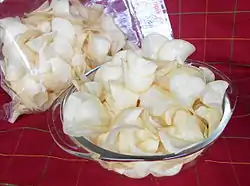 Kripik singkong (cassava) kripik | |
| Course | Snack |
|---|---|
| Place of origin | Indonesia[1] |
| Region or state | Nationwide |
| Serving temperature | Room temperature |
| Main ingredients | Deep fried dried ingredients |
| Variations | Different variations according to ingredients |
 |
| This article is part of the series on |
| Indonesian cuisine Masakan Indonesia |
|---|
|
|
Together with krupuk, the etymology of the term kripik is believed as an onomatopoeia in Indonesian to describe the crunch sound of this crispy snack.[3]
Kripik (chips) and krupuk (crackers) are an integral part of Indonesian cuisine.[4] Kripik commonly are made from dried slices of roots and tubers. The most popular are kripik singkong (cassava crackers) and kripik pisang (Banana chips); other types of fruit, yam or tuber crackers are also available.
Kripik and krupuk
Kripik is closely related to krupuk since it is popularly considered as a smaller sized krupuk. In Indonesia, the term krupuk refers to a type of relatively large crackers, while kripik or keripik refers to smaller bite-size crackers; the counterpart of chips (or crisps) in western cuisine. For example, potato chips are called kripik kentang in Indonesia. Usually krupuk are made from a dried paste consisting of a mixture of starch and other ingredients, while kripik are usually made entirely from a thinly sliced, sun-dried, and then deep-fried product without any mixture of starch.[4]
Variants

Almost all type of fruits, nuts, tubers and plant products can be made into kripik. Other types of kripik can be coated with batter and deep fried until crispy and dry. In Indonesia, the latest popular snack is extra hot and spicy kripik.
- Emping is a type of kripik made from the melinjo (Gnetum gnemon) nut.
- Kripik apel, made from dried apple, originally produced in Malang, East Java
- Kripik bayam, made from spinach
- Kripik belut, made from battered and deep-fried eel
- Kripik ceker, made from deep-fried boneless chicken feet
- Kripik durian, from Medan
- Kripik gadung, made from gadung yam (Dioscorea hispida)
- Kripik jamur, made from mushrooms
- Kripik kentang, made from potato
- Kripik nangka, made from jackfruit
- Kripik oncom, made from oncom, similar to kripik tempeh but has slightly bitter taste
- Kripik pisang, made from dried banana
- Kripik salak, made from snake fruit[5]
- Kripik sanjay or kripik singkong balado, thin crispy cassava coated with chili pepper and sugar – a popular snack from Bukittinggi, West Sumatra
- Kripik singkong, made of cassava. A spicy variant is available in Bandung, West Java, commonly called by its brand name maicih.
- Kripik sukun, made from breadfruit
- Kripik talas, made from taro
- Kripik tempe, made by deep-frying batter coated tempeh
- Keripik teripang, made from dried sea cucumber
- Kripik ubi, made from sweet potato
- Kripik walang or kripik belalang, made from grasshopper
Product
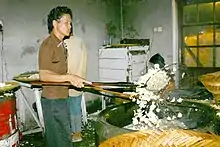
Kripik are traditionally made by a small-scale home industry.[6] However, just like the potato chip industry in the western counterpart, in Indonesia today it is common to encounter mass-produced packed kripik snacks in warung shops, minimarkets and supermarkets. Some brands have mass-produced certain variants of kripik chips.[7]
In Indonesia, kripiks are often sold as oleh-oleh or food gift to be brought home after travel. Certain areas has developed their specialty kripiks which depend on locally available ingredients and recipes. For example, Lampung is well known for its banana kripiks,[8] Malang in East Java for its fruit-based kripiks, including apple and jackfruit kripiks,[9] while Bandung is well known for its tempeh, oncom, tubers and sweet potato-based kripiks.[10] Bukittinggi city in West Sumatra on the other hand, is famous for its Keripik sanjay, a hot and spicy cassava chips coated with balado chili sauce.[11]
As of 8 February 2018 the latest trend in Indonesia's kripik industry is extra hot kripiks with ample chili powder, which started with Keripik Pedas Maicih (Maicih spicy crackers) in Bandung in 2010. It is a bag of fiery hot cassava chips offered in different levels of spiciness. Subsequently, the popularity of extra hot kripik ' swept across nation.[12]
Gallery
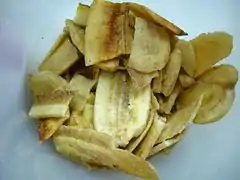
 Kepok banana kripik
Kepok banana kripik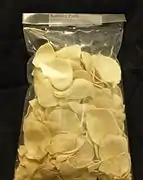 Gadung (Dioscorea hispida) kripik
Gadung (Dioscorea hispida) kripik Sweet potato kripik
Sweet potato kripik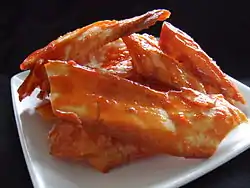 Kripik sanjai, cassava-chili kripik
Kripik sanjai, cassava-chili kripik Durian kripik
Durian kripik Tempeh kripik
Tempeh kripik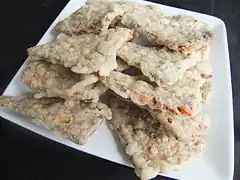 Oncom kripik
Oncom kripik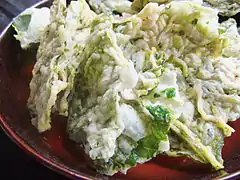 Spinach kripik
Spinach kripik Chicken feet kripik
Chicken feet kripik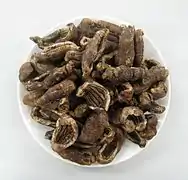 Keripik teripang, sea cucumber kripik
Keripik teripang, sea cucumber kripik
See also
References
- Sr, A. L. N. Kramer; Koen, Willie; Davidsen, Katherine (12 February 2013). Tuttle Concise Indonesian Dictionary: Indonesian-English English-Indonesian. Tuttle Publishing. ISBN 9781462910861.
- "Kripik Pisang" (in Indonesian). IPTEKnet. Archived from the original on 11 May 2012. Retrieved 28 June 2012.
- Kompasiana.com. "Onomatopoeia, Dari Kuping Turun ke Lidah oleh Gustaaf Kusno". kompasiana.com (in Indonesian). Retrieved 29 January 2018.
- An Atlas of Biodiversity in Indonesia. State Ministry of Environment. 1995. p. 43.
- Liputan6.com. "Keripik Salak Kekinian, Teman Ngopi di Sore Hari". liputan6.com (in Indonesian). Retrieved 28 January 2018.
- "Gurih Laba Industri Keripik Singkong". Tribun Jambi (in Indonesian). Retrieved 28 January 2018.
- "Product". Kusuka. Retrieved 28 January 2018.
- "Gang PU, Surganya Keripik Pisang Aneka Rasa Khas Lampung". Tribun Lampung (in Indonesian). Retrieved 29 January 2018.
- "The scrumptious fruit chips of Batu, East Java". Retrieved 29 January 2018.
- "Oleh-oleh Leuwipanjang, Penjualan Keripik Tempe 500 kg/Hari". Tribunnews.com (in Indonesian). Retrieved 29 January 2018.
- Kaya, Indonesia. "Karupuak Sanjai, Keripik Renyah Menggoda Khas Bukittinggi | IndonesiaKaya.com – Eksplorasi Budaya di Zamrud Khatulistiwa". IndonesiaKaya (in Indonesian). Retrieved 29 January 2018.
- "Food of the Month: Keripik Pedas Maicih". Good Indonesian Food. 24 May 2016. Retrieved 29 January 2018.
External links
| Wikimedia Commons has media related to Keripik. |